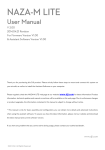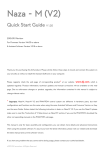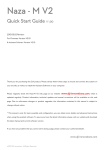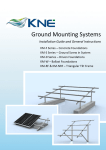Download Naza V2 Manual - Personal Drones
Transcript
Naza for Multi-Rotor User Manual V 2.0 www.dji-innovations.com Warning & Disclaimer Naza is an excellent autopilot system offering tremendous flight features for low altitude multi-rotor working in restricted space compared to normal helicopter. It is not a toy when installed in multi-rotors of any size. Please respect the AMA’s National Model Aircraft Safety Code. Despite our efforts in making the controller to operate in the safest manner when the main power battery is connected, such as: disabling MC signal to ESCs when USB is connected; disabling throttle input and stick command when throttle stick is not at the lowest position, we strongly recommend customers to remove all propellers, use power supply from R/C system or flight pack battery, and keep children away during system calibration and parameter setup. Dajiang Innovation Technology Co. Ltd. assumes no liability for damage(s) or injuries incurred directly or indirectly from the use of this product. Please strictly follow these steps to mount and connect Naza on your multi-rotor, as well as to install the assistant software on your computer. 2| Product Profile DJI Naza for multi-motors is an autopilot system designed for serious multi-rotor enthusiasts providing excellent self-leveling and altitude holding, which completely takes the stress out of flying RC multi-rotors for both professional and hobby applications. Naza can be installed in a variety of models from quad-rotor to hexa-rotor. No GPS Atti. Mode without GPS module Naza Control Modes GPS Atti. Mode Atti. Mode Manual Mode Rudder Angular Maximum rudder angular velocity is 200°/s Velocity Command Stick Multi attitude control; Stick center position for 0˚ Meaning attitude, its endpoint is 45˚. Max-angular velocity is 150°/s. No attitude angle limitation and vertical velocity locking. Command YES Linearity Lock position if GPS Stick Released Only attitude stabilizing. NOT Recommend signal is adequate. Maintain the altitude best above 1 meter from Altitude Lock NO ground. After 10s when Only performing attitude GPS signal lost, GPS Lost stabilizing without --- system enters Atti. position lock. Mode automatically. Attitude & speed mixture control ensures stability Safety Applications Depends on experience. Enhanced Fail-Safe Auto Level Fail-Safe AP work Sports flying. --- 3| In Box Main Controller (MC) ×1 The Main Controller (MC) is the brain of the system, it communicates with ESC and RC transmitter to carry out autopilot functionality. It has a built-in Inertial Measurement Unit (IMU) consists of one 3-axis accelerometer, one 3-axis gyroscope and a barometer for sensing the attitude and altitude. Versatile Unit (VU) ×1 Specially designed for Naza. It solves the high power consumption problem of multi-rotor system, supply and monitor power for Naza and other electronic devices. It also has a LED to indicate different states of Naza and a USB interface for configuration and firmware upgrade. Optional GPS & Compass Module ×1 The GPS/Compass module is for sensing the position and direction. Optional GPS Bracket ×1 Because the GPS & Compass are sensitive to magnetic interference, you should use this bracket to mount the GPS module. USB Cable ×1 This cable is used to configure MC and upgrade firmware. 3-PIN Servo Cable ×8 Cables used to connect the MC and the receiver. 3M Gummed Paper ×4 For fixing Naza components on multi-rotor’s frame. 4| Contents WARNING & DISCLAIMER ...............................................................................................2 PRODUCT PROFILE ..........................................................................................................3 IN BOX ............................................................................................................................4 CONTENTS ......................................................................................................................5 MATTERS NEED ATTENTION............................................................................................6 ASSEMBLY ......................................................................................................................8 ASSISTANT SOFTWARE....................................................................................................9 SOFTWARE AND DRIVER INSTALLATION.......................................................................................9 GUI ....................................................................................................................................9 FIRMWARE UPGRADE ...........................................................................................................11 PRODUCT INFO & UPGRADE ..................................................................................................11 CONFIGURATION .......................................................................................................... 12 1 MOUNTING .....................................................................................................................12 2 MOTOR MIXER ................................................................................................................13 3 TX MONITOR ...................................................................................................................15 4 AUTOPILOT ......................................................................................................................19 5 GIMBAL ..........................................................................................................................26 6 VOLTAGE MONITORING .....................................................................................................28 FLIGHT .......................................................................................................................... 31 DIGITAL COMPASS CALIBRATION ............................................................................................31 FLY TEST ............................................................................................................................33 FLY WITH GPS ....................................................................................................................35 APPENDIX ..................................................................................................................... 36 MULTI-ROTORS SUPPORTED ..................................................................................................36 PORT DESCRIPTION ..............................................................................................................37 LIGHT DESCRIPTION .............................................................................................................38 SPECIFICATIONS ..................................................................................................................39 5| Matters Need Attention For safety reasons, please pay serious attention to all following items: 1. For big aircraft that is larger than 650 or with heavy load, WKM is recommended. 2. When aircraft mounted, please ensure the aircraft center of gravity is lie on the center of the frame, for aircraft with load in the vertical direction of frame center. 3. When MC mounted, try your best to mount the MC at the center of the frame, and do not mount the MC upside-down. Make sure MC is parallel to the aircraft horizon, so as to prevent the aircraft from drifting in horizontal direction. 4. Make sure the MC ESC ports is pointing to the aircraft nose direction, otherwise serious damage will occur to your aircraft. 5. Disconnect ESCs and battery or remove all propellers during configuration and system setup! 6. You have to reboot MC and redo the Tx calibration after you change the RC system. 7. In Tx Calibration of assistant software: 8. Throttle: Slide left is craft down, slide right is craft up; Rudder: Slide left is nose left, slide right is nose right; Elevator: Slide left is craft back, slide right is craft front; Aileron: Slide left is craft left, slide right is craft right. Make sure switch on the transmitter first, then power on multi-rotor before takeoff! Power off multi-rotor first, then switch off the transmitter after landing! 9. No matter the gimbal control in assistant software is on or off during the configuration, please note that there is output from F1 and F2 ports. Now you should not connect these ports to ESCs which is wired with propellers and motors. 10. Do NOT set the failed-safe position of throttle under 10% of endpoint. 11. Throttle stick position should always be higher than 10% from cut-throttle during the flight! 12. Low voltage protections are NOT fun! You should land your multi-rotor ASAP in any protection level to prevent your multi-rotor from crash or other harmful consequences! 13. By using Immediately mode to stop motors, in any control mode, once motors start and throttle stick is over 10%, motors will stop immediately when throttle stick is back under 10% again. In this case, if you push the throttle stick over 10% in 5 seconds after motors stop, motors will re-start; Combination Stick Command (CSC) is no need. If you don’t push throttle stick after motors start in three seconds, motors will stop automatically. 14. By using Intelligent mode to stop motors, motors will start or stop immediately when you execute CSC. During normal flight, only pull throttle stick under 10% will not stop motors in any control mode. You have to execute CSC to re-start motors if they stop during the flight. 6| 15. Red light quick blinking indicates battery voltage is low, please land ASAP. 16. Do NOT move any command sticks during system start and self-check! Please contact us if the last four green blinks are abnormal. 17. GPS/Compass is sensitive to magnetic interference, should be far away from any electronic devices. 18. Do not fly in GPS Mode when the signal is not good (red light blinks)! 19. GPS module is optional (Nonstandard). Users use GPS module should read contents about GPS matching in indicators; users without GPS module can skip contents about GPS. 20. If users set GPS Atti. Mode in Control Mode Switch without connecting to GPS module, the M.C. will switch GPS Atti. Mode into Atti. Mode automatically, and LED indicator is yellow blinks. 21. Once work in Fail-Safe Mode, with GPS the aircraft will auto flameout when landed; without GPS the aircraft will not auto flameout when landed. 7| Assembly R/C System VU · These are example connections. Please setup Aileron, Elevator, Throttle, Rudder channels on your Tx f i r s t , a n d c h o o s e o n e 2 positions switch/channel (3 positions switch with GPS) as control mode switch, then connect your receiver to the right ports on MC. · · To Battery · · 2/3-position switch channel R/C Receiver (JR) RUDD ELEV AILE THRO · · R/C Receiver (Futaba / Hitec) 1 2 3 4 接电调 ESC M1-6 2/3-position switch channel Do not mount it on any other electronic devices. Make sure You can see the LED light during the flight. If use with DJI multi-rotor, you can solder the VU power cable to power pads on frame bottom board. Please refer to DJI multi-rotor manual for details. If use with 3rd part multi-rotor, you can make a connecter by yourself to connect VU, ESCs and battery. ESCs, Motors Motors and ESCs in DJI multi-rotor kit are recommended. Please make sure you are using the ESCs and motors recommended by the manufacturer of your multi rotor first. NAZA output is 400Hz refresh frequency. Connect all ESCs to MC by the motor numbering method introduced in our Assistant software. If you use 3rd party ESCs, please make sure the ESCs travel midpoint is at 1520us. DO NOT use 700us travel midpoint ESC, as it may lead aircraft to fly away or cause injury and damage. After connect ESCs to motors, calibrate all your ESCs one by one through the receiver directly before connect them to your MC, Make sure program all of them into Governor off, Break off and Normal Start up to get best experience. 接云台 Futaba S-Bus S-Bus F2 Roll Aircraft Nose Pitch F1 GPS/COMPASS · · Optional · · · GPS/Compass is sensitive to magnetic interference, should be far away from any electronic devices. You should use epoxy resin AB glue to assemble the GPS bracket first as the figure showed in previous page. Mount the bracket on the center plate of craft first, then fix the GPS on the plate of the bracket (by 3M glue provided). The GPS is sensitive to vibration interference, so position the bracket at least 10 cm from any rotor. The DJI logo marked on the GPS should face the sky, with the orientation arrow pointing directly forward. The GPS/Compass is packaged with a special indication line for mounting for the first time. If you are uncertain whether materials near the GPS/Compass module are magnetic or not, you can use a compass or magnet to check it. If you use your own mounting rod, make sure it is NOT magnetic! MC · Please use 3M gummed paper provided To mount MC, and mount MC parallel to the aircraft horizon. · The output ports of MC (the right side in figure) should point to the front of multi-rotor. You’d better put MC at the gravity center of multi-rotor. Please make sure all ports are accessible when installing the MC so as to facilitate wiring and software configuration. · In three-pin ports, pins near the nicks are signal pins. · After choosing a location to mount the MC, it is recommended that you DO NOT mount the MC until all wirings and software configurations are completed. 8| Assistant Software Software and Driver Installation STEP1: Please download assistant software and driver from our website. Then decompress. STEP2: Connect MC and PC via USB cable, power on MC. STEP3: If operating system tries to install driver automatically, cancel it. STEP4: Open folder DJI_USB_Driver, follow the Driver Installation Manual strictly to finish installation. GUI 1 5 13 1 2 6 14 15 3 7 4 9 8 12 11 10 TOOL Firmware upgrade: update your firmware from server, keep your autopilot system up-to-date. Disable All Knob Check for Updates: Check out the latest versions of assistant software and firmware. If necessary, 9| you can follow the links displayed to find the download page. 2 ABOUT Info: Information regarding your product. Error Code 3 中文: Chinese interface. 4 ENGLISH: English interface. 5 EXPORT: Export configure data. 6 IMPORT: Import vertion compatible configure data. 7 WRITE: Write data of the current page to your MC. The parameter or the title of which will turn red and bold when modified, make sure you click the Write button or press Enter to update your system. Optional parameters will be written to MC directly after modification. 8 READ: read parameters from MC for current page. 9 Graphic guidance 10 Text guidance 11 CONTROL MODE: Control mode indication. 12 MC Output On Indicates there are outputs to ESCs; when communication is built up between MC and assistant software via USB cable, MC Output Off appears, it indicates no output to motors, then you can configure your multi-rotor with assistant software more safely! 13 Red light: MCPC has been disconnected. Green light: MCPC has been connected. Blue light: MCPC communication. 14 Here you can find all the configuration contents in Configuration chapter 15 Configuration step. Notices: Please power the MC first, then connect your MC to a internet enabled computer by the USB cable before you open the assistant software. You have to register at the first time you use the assistant software. It will auto detect software version when you open the assistant software and prompt Check for Updates window if your version is not the latest one. Do not disconnect MC and PC when you are using the assistant software.. 10 | Firmware Upgrade Please strictly follow the procedure for firmware upgrade, otherwise autopilot might not work properly: STEP1: Make sure your computer is connected to the Internet. STEP2: Please close all the other applications during the firmware upgrade, including anti-virus software and firewall. STEP3: Make sure the power supply is securely connected. DO NOT un-plug the power supply until firmware upgrade has finished. STEP4: Connect MC to PC with micro-USB cable, DO NOT break connection until firmware upgrade is finished. STEP5: Run Software and wait for connection. STEP6: Select TOOLFirmware Upgrade. STEP7: Server will check your current firmware version, and get the latest firmware prepared for the unit. STEP8: If there is a firmware version more up-to-date than your current version, you will be able to click the Upgrade button. STEP9: Wait until Assistant software reads finished. STEP10: Click OK and power cycle the unit after at least 5 seconds. Your unit is up-to-date now. Notices: After firmware upgrade, please re-configure by Assistant software. If it is notified that the network or server is busy, please try again later with above procedures. If firmware upgrade failed, MC will enter waiting for firmware upgrade status automatically, please try again with the above procedures. Product Info & Upgrade You can check the MC product version via ABOUT Info: Software Firmware Loader Hardware ID S/N is a 32 digits authorization code for unit function activations. We had already filled in the authorization code for your unit after manufacture. You might be asking to fill in the new S/N in the future if you brought new function upgrades. Fill-in the S/N and then click Write button. If you filled in an invalid S/N over 30 times, your MC will be locked and you have to contact our customer support. 11 | Configuration 1 Mounting Without GPS, please skip this step STEP1: Mounting Location Install all payloads that will be used during the flight, including batteries, camera mount and camera. Balance the multi-rotor as you would normally, with the center of gravity (C.G.) directly on the center plate. Fill in the distance between body center of GPS and the C.G. of multi-rotor in X, Y & Z axles as showed in the figure. Make sure the MC ESC ports is pointing to the aircraft nose direction, otherwise serious damage will occur to your aircraft. When MC mounted, try your best to mount the MC at the center of the frame, and do not mount the MC upside-down. Make sure MC is parallel to the aircraft horizon. Notices: 1 Users with GPS module please mount GPS location. 2 Please follow the requirements to mount your Naza MC, so as to prevent the aircraft from abnormal, such as drifting in horizontal direction, or even rollover. 3 You must re-configure if the ALL-UP-WEIGHT had been changed on your multi-rotor, 4 If GPS mounting locations are not accurate enough or the signs are wrong, error on X, Y,Z axles will leads the oscillation of your multi-rotor. 5 Make sure to follow the diagram in our assistant software: red is positive, green is negative; unit of measure is CM, NOT INCH. 12 | 2 Motor Mixer STEP1: Mixer Type Set your transmitter into ACROBATIC mode. Then select the right mixer type according to your multi-rotor. Tips: We support six types of multi-rotors. Refer to Multi-Rotors Supperted in Appendix: Notices: Do NOT follow instruction from 3rd party multi-rotor manufacturer! Make sure the rotation direction of each motor is the same as the way up figure shows. If not, switch any of two wire connetcions of the incorrect motor to change its rotation direction. Make sure the type of propeller matches the rotation direction of the motor. STEP2: Motor Idle Speed Motor Idle Speed is the lowest speed after motor start. Set Motor Idle Speed will affect motor lowest speed after motor start. There are five levels from LOW speed to HIGH speed, and the default is RECOMMEND. You can click and drag cursor to the corresponding level, to change Motor Idle Speed. LOW RECOMMEND The lower motor idle speed HIGH The higher motor idle speed Set Motor Idle Speed as LOW, the motor idle speed will be lowest. Set Motor Idle Speed as HIGH, the motor idle speed will be highest. RECOMMEND is the advised level. You can reset the Motor Idle Speed according to the real situation. 13 | Notices: For user whose aircraft takes off at lowest throttles position, please set the idle speed at a low level. For common users, please set Motor Idle Speed to RECOMMEND or above, since setting idle speed too low may affect motor(s) spool up. Tips: The output pulse width for every grade of Motor Idle Speed is as followed LOW output pulse width 1144 us RECOMMEND 1160 us 1176 us HIGH 1192 us 1208 us There is relationship between the output pulse width and the max/min pulse width when TX End Point is 100%. output pulse width=(max pulse-min pulse) x proportion + min pulse You can get the proportion value by computing according to the above formula for a special TX. Use Futaba TX for example. Notice that Futaba TX End Point is 100%. LOW proportion value 3% RECOMMEND 5 7% HIGH 9% 11% 14 | 3 Tx Monitor Notices: Make sure you have removed all propellers before this step! STEP1: Receiver Type Choose the type of your receiver. If you use S-Bus receiver, please choose S-Bus compatible option: D-Bus. Otherwise choose Tradition. Notices: Please reboot MC and redo the calibration after you change the setup of your transmitter or change your receiver! Tips: If you use S-Bus receiver, the communication of A, E, T, R, U, X1 and X2 channels are all through the D-Bus channel. Right figure shows the connection of default transmitter channels and MC channels in S-Bus receiver (Only first 8 channels of S-Bus receiver are used at the moment). Transmitter Channels 1 2 3 4 5 6 7 MC Channels A E T R U X1 X2 STEP2: Cut Off Type Please read the introductions of start and stop motor in this step first, and then choose a cut off type. 1 Start Motor: Pushing throttle stick before takeoff will not start motors. You have to execute any one of following four Combination Stick Commands (CSC) to start motors: 15 | 2 Stop Motor: We provide two options to stop motors: Immediately, Intelligent. Immediately Mode: By using this mode, in any control mode, once motors start and throttle stick is over 10%, motors will stop immediately when throttle stick is back under 10% again. In this case, if you push the throttle stick over 10% in 5 seconds after motors stop, motors will re-start, CSC is no need. If you don’t push throttle stick after motors start in three seconds, motors will stop automatically. Intelligent Mode: By using this mode, different control mode has different way of stopping motors. In Manual Mode, only executing CSC can stop motors. In Atti Mode or GPS Atti. Mode, any one of following four cases will stop motors: a) You don’t push throttle stick after motors start in three seconds; b) Executing CSC; c) Throttle stick under 10%, and after landing 3 seconds. d) The slope angle of multi-rotor is over 70°, and throttle stick under 10%. Tips (Intelligent Mode): You have to execute CSC to start motors. Push throttle stick only will not start motors. In Atti. / GPS Atti. Mode, it has landing judgment, which will stop motors. Start motors in Atti. / GPS Atti. Mode, you have to execute CSC and then push throttle stick over 10% in 3 seconds, otherwise motors will stop after 3 seconds. During normal flight, only pull throttle stick under 10% will not stop motors in any control mode. For safety reason, when the slope angle of multi-rotor is over 70°during the flight in Atti. / GPS Atti. Mode (may be caused by collision, motor and ESC error or propeller broken down), and throttle stick is under 10%, motors will stop automatically. You can stop motors by executing CSC in any control mode. Notices: 1. All these two cut off types will work properly only if Tx calibration is correct. 2. When Tx commands are valid under any control modes, motors will start or stop immediately when you execute CSC. It has nothing to do with current throttle stick position. Please DO NOT executes CSC during flight without any reason. 3. If you choose Immediately mode, you should not pull throttle stick under 10% during flight, because that will stop motors. If you do it accidentally, you should push the throttle stick over 10% in 5 seconds to re-start motors. 16 | 4. If you choose Intelligent mode, throttle stick under 10% will trigger landing judgment in any control mode. In this judgment, pitch, roll and yaw controls are denied except throttle, but multi-rotor will still auto level. 5. In any control mode, DO NOT pull throttle stick under 10% during normal flight without any reason. 6. In failed-safe, CSC is denied by MC, motors will hold state. STEP3: Command Sticks Calibration Slides Moving Definition: T : Slide left is craft down, slide right is craft up; R : Slide left is nose left, slide right is nose right; E : Slide left is craft back, slide right is craft front; A : Slide left is craft left, slide right is craft right. STEP1: Set endpoints of all channels to default values (100%) and set all trims and sub-trims of sticks to 0 on your transmitter first. Keep all curves’ settings as default since the end-point of transmitter sticks will be recorded here. STEP2: Click START button, and move all of the sticks throughout their complete range several times. STEP3: After that, click FINISH button when you finished above procedures. STEP4: If the moving direction of the slide is opposite to the Slides Moving Definition, click the reverse button REV/NORM beside. Notices: 1. All slides should become when all the sticks are in the middle positions. If slides cannot go back to center points (become ), just click FINISH, then slides will be at center automatically. If still not, please reboot MC, and do not apply Tx command during the reboot. 2. CSC may not start motors If trims and sub-trims of sticks are not 0! STEP4: Sticks Monitor This step is optional. X1 and X2 is for remote gain tuning; X1 is also for gimbal pitch control. Setup the channel on your RC correctly. STEP5: Control Mode Switch Whichever 2 or 3 positions switch on your transmitter you have selected to use as control mode switch, wire the right channel of receiver to U port of MC. At each switch position, use end-point fine tuning on your 17 | transmitter, move the slider of channel U to GPS (GPS Atti Mode), A (Atti. Mode), M (Manual Mode) to turn the corresponding area blue respectively as showed in the figure. Tips: To move the slider is to adjust channel-selected end-points. 3 Position Switch 1 2 3 Tx For 3-position switch, you should assign: Position-1 to Manual Mode; Position-2 to Atti. Mode; Position-3 to GPS Atti. Mode; 2 Position Switch 1 2 Tx or reverse the assignment for Position-1 and Position-3. For 2-positions switch, you can assign any two of these three control modes as you like. If your transmitter supports Fail-Safe, then move the slider to the range which reads Fail-Safe Mode to turn the area blue, set Fail-Safe output of receiver to input port-U. If you switch off your transmitter now, the U channel slide should move to Fail-Safe and turn the corresponding area to blue. Otherwise please reset the fail-safe. MC has built-in auto level Fail-Safe function. That means when the communication between MC and transmitter is disconnected, the outputs of all command sticks from MC will go to center point. If your transmitter has only 4 channels, then MC will work in Atti. Mode by default without Fail-Safe function. Tips: Please refer to your RC manual for the details of fail-safe setup. With GPS, it is Enhanced Fail-Safe; without GPS, it is Auto Level Fail-Safe, and the aircraft will land. Notices: 1. Do NOT set the fail-safe position of throttle under 10% of endpoint. 2. MC would not execute Fail-Safe protection if you don’t set it properly. You can verify the Fail-Safe settings by shutting down your transmitter, and then you can use the following method to check whether MC is already in Fail-Safe mode. Check status bar at the bottom side of the software interface. Control mode will change to Fail-Safe. Check the LED indicator. Read the appendix in this manual for details. LED will give fast yellow blinking if in fail-safe mode. 3. If your transmitter does not support Fail-Safe, the Fail-Safe function will not work when the communication between MC and transmitter is disconnected. 4. Do not use 4-channel Futaba transmitter with S-Bus receiver, otherwise MC will work in Fail-Safe mode. 5. If users set GPS Atti. Mode in Control Mode Switch without connecting to GPS module, the M.C. will switch GPS Atti. Mode into Atti. Mode automatically, and LED indicator is yellow blinks, that is, 3-poisitions switch is the same as 2-positions switch. 6. Once work in Fail-Safe Mode, with GPS the aircraft will auto flameout when landed; without GPS the aircraft will not auto flameout when landed. 18 | 4 Autopilot STEP1: Basic Parameters Usually, the default parameters are ready to go. However, different multi-rotors have different gains because of different size, ESC, motor and propeller. If gain is too large, you will find the multi-rotor oscillating in the corresponding direction (About 5~10Hz). If too small, the multi-rotor will likely to be hard to control. So you can still setup the basic Gain of Pitch, Roll, Yaw and Vertical manually according to your multi-rotor to have a wonderful fly experience. We suggest you to change 10% to 15% of the parameter at a time. To the gains of Pitch and Roll, if you release the Pitch or Roll stick after command stick, multi-rotor should be back to hovering state. If the reaction of multi-rotor in this procedure is too soft (large delay), please increase the basic gain slowly (10%-15% each time) until vibration emerges after you release the stick. Then decrease the gain a little until vibration just disappears. Now the gain is perfect, but the reaction of the attitude change is slow. You can follow the way introduced at the end of this section to tune the attitude gains. The way of tuning the Yaw gain is the same as the way of adjusting the Tail Gyro. If you want fast stick reaction speed, increase the gain, otherwise decrease the gain. However, the spin of multi-rotor is produced by the counter torque force, and the magnitude of which is limited. Therefore, large gain will not produce tail vibration like helicopter, but severe reaction at the start or stop of motors, which will affect the stabilization of the other directions. You use two methods to judge if the Vertical gain is good enough: 1) The multi-rotor can lock the altitude 19 | when the throttle stick is at center position; 2) The change of altitude is small during the flight along a route. You can increase the gain slowly (10% each time) until the vibration emerges along the vertical direction or the reaction of throttle stick is too sensitive, then decrease 20% of the gain. Now it is a suitable Vertical gain. Attitude gains determine the reaction speed of attitude from command stick, the bigger the value the quicker the reaction. Increase it for sharper and quicker leveling action after command stick released. Unstable shaking flying and the control feeling will be stiffness and rigid if the value is too high; and sluggish leveling action and slow braking if too small. Notices: You must upgrade firmware first, then click Default button in first setup parameter. The vertical gain will NOT affect the manual mode. The final flight performance is decided by the autopilot parameters and all parts of multi-rotor (includes mechanical structure, motors, ESCs, propellers and battery). If these parts are not compatible, you cannot get good flight performance by adjusting the autopilot parameters. Therefore, if you have high requirement to flight performance, you’d better get a multi-rotor with good integration test. Tips: If you are a fresh player, you can tune the basic parameters first as following: 1 Increase the basic parameters 10% at a time so as to make your multi-rotor hover or light oscillate after small angular command input. 2 Decrease the basic parameters until your multi-rotor can just hover, then decrease 10% more. Here you can make use of remote gain-tuning channels to tune the gains during the flight: 1 Followed the instructions in Assembly R/C System section to connect and setup correctly; 2 Choose the X1 or X2 channel in Remote Adjust for the gain you want to tune. One channel to one gain. 3 The range of remote tuning is from half current value to twice current value. Usually the Pitch, Roll, Attitude Pitch and Attitude Roll Gains of hexa-rotor are high then quad-rotor. STEP2: Enhanced Failed-Safe Methods Without GPS, please skip this step Enhanced Fail-safe method will be triggered when MC loses the control signal. This could be one of the following situations: 1) Signal lost between transmitter and receiver, e.g. multi-rotor is out of the communication range, or 20 | transmitter is down, and so on. 2) One or more connections of A, E, T, R, U channels between MC and receiver loses. If this happens before take-off, motors will not work if you push the throttle stick; if this happens during the flight, LED yellow light will flash to warn in addition to the failed-safe method. If Hovering failed-safe method is triggered and U channel is disconnected, multi-rotor will auto land. Choose one method for your failed-safe function, Hovering or Go Home and Landing. Hovering: the aircraft will land after 6s hovering. Go Home and Landing: Before takeoff, current position of multi-rotor will be saved as home point by MC automatically when you push the throttle stick first time after 6 or more GPS satellites are found ( blinks once or no blinking) 8 seconds. Notices: When switch to Manual Mode or Atti. Mode, MC will disengage enhanced failed-safe mode, you can re-gain control of multi-rotor. Tips: The following schematic shown is introduction for Go-Home and Landing. Home Location If GPS satellite found >= 6 , at the first you pull the throttle stick, then record Home Location Ground Multi rotor 1 Stay hover Signal lost Tx Tx 2 3 Current location higher than 20m Ready to Go-Home Go back first 20m Signal lost > 3s Tx Hover 15s , Then land. Current location lower than 20m Tx Tx 4 5 6 STEP3: Intelligent Orientation Control Without GPS, please skip this step Forward Direction: Multi-rotor will fly along this direction when you push the elevator stick. Usually, the forward direction of a flying multi-rotor is the same as the nose direction. By using Intelligent Orientation Control (IOC), wherever the nose points, the forward direction has nothing to do with nose direction: In course lock flying, the forward direction is the same as a recorded nose direction. See the following figures (Mode 2): 21 | In course lock Usually In home lock flying, the forward direction is the same as the direction from home point to multi-rotor. See the following figures (Mode 2): Usually In home lock Home point Home point Before using this function, you have to choose a 2 or 3 positions switch on your transmitter as IOC switch. Then wire the right channel of receiver to X2 port of MC. At each switch position, use end-point fine tuning on your transmitter, move the slider of channel X2 to Home Lock, Course Lock, OFF to turn the corresponding area blue respectively. Tips: 1 3 Position Switch For 3-position switch: 2 3 Tx Position-1 is OFF; Position-2 is Course Lock; Position-3 is Home Lock. For 2-position switch: Position -1 is OFF; Position-2 is Course Lock. Or Position -1 is OFF; Position-2 is Home Lock. If you use S-Bus receiver, the default channel connection is shown in Tx Monitor – Receiver Type section. Then you only need to assign a 2 or 3-position switch of your transmitter to the 5th channel. Notices: Do NOT set a 2-position switch as: Position-1 is Course Lock; Position-2 is Home Lock. Course Lock Usage: During the same flight: STEP1: Record STEP1: a) STEP2: Open STEP3: Close Nose direction; Forward direction STEP4: Re-open Record forward direction: There are two ways: Manually; Automatically: Automatically: MC will record the current nose direction as forward direction at 30 th second 22 | after you power on the multi-rotor. And LED will blink b) quickly if recording is successful. Manually: You can slide X2 channel switch between OFF and Course Lock position quickly 3 to 5 times to record current nose direction as new forward direction at any time after you power on multi-rotor 30 seconds. And LED will blink STEP2: quickly if recording is successful. Open course lock: After record the forward direction successfully, if MC is in Atti. or GPS Atti. Mode, then you can slide X2 channel switch to Course Lock position to fly in course lock. Now wherever the nose points, the real flight forward direction is the same as the recorded forward direction, and LED will blink STEP3: slowly to indicate the IOC mode. Close course lock: There are two ways: a) Slide X2 channel switch to OFF position to quit course lock; (Recommended way!) b) Slide U channel switch to Manual Mode position, or close transmitter, or fly in waypoint mode. STEP4: Re-open course lock: If you want to re-open course lock after you quit this function, you should first slide X2 channel switch to OFF position, and slide U channel switch to Atti. or GPS Atti. mode position, then slide X2 channel switch to Course Lock position to re-open course lock. Home Lock Usage: During the same flight: STEP1: Record Nose direction; STEP1: STEP2: Open Forward direction; STEP3: Close Home point; STEP4: Re-open Over 10m distance Record home point: The home point mentioned here is the same home point of enhanced Fail-Safe. There are two ways to record here: Manually; Automatically: a) Automatically: Before takeoff, current position of multi-rotor will be saved as home point by MC automatically when you push the throttle stick first time after 6 or more GPS satellites have been found ( b) blinks once or no blinking) for 8 seconds. Manually: When 6 or more GPS satellites are found ( blinks once or no blinking), you can slide X2 channel switch between (to a 3-position switch) Course Lock and Home Lock or (to a 2-position switch) OFF and Home Lock position quickly 3 to 5 times to record current position of multi-rotor as new home point. And LED will blink quickly if recording is successful. STEP2: Open home lock: Slide X2 channel switch to Home Lock position to fly in home lock when all 23 | the following requirements are met: a) Home point is recorded successfully; b) 6 or more GPS satellites are found; c) In GPS Atti. Mode; d) Multi-rotor is further than 10m away from home point. Now wherever the nose points, the real flight forward direction is the same as the direction from home point to multi-rotor, and LED will blink STEP3: slowly to indicate the IOC mode of MC. Close home lock: There are three ways: a) Slide X2 channel switch to OFF position to quit home lock; (Recommended way!) b) Slide U channel switch to Manual Mode position, or close transmitter, or fly in waypoint mode. c) MC will be in course lock by current forward direction automatically when multi-rotor flies back into 10m range around home point, or MC is in Atti. Mode. STEP4: Re-open home lock: If you want to re-open home lock after you quit this function, you should first slide X2 channel switch to OFF position. When all 4 requirements in the 3rd step are met, slide X2 channel switch to Home Lock position to re-open home lock. Tips: 1 LED will blink slowly to indicate the IOC mode only when MC is really fly in course lock or home lock. 2 We suggest that you should know clearly that, by which lock method you are going to fly, and the locked forward direction or home point, before you switch on IOC mode during the flight. 3 There is only one home point recorded at any time. This point is the same one used by Go-Home and Landing fail-safe. 4 When flying by home lock, if GPS signal becomes weak, MC will be in course lock by current forward direction automatically. 5 You’d better stand near the home point to use home lick. 6 You’d better use 3-position switch for X2 channel, and you’d better use X2 channel switch to open and close IOC during the flight. Notices: 1 Before home lock flight, you’d better fly the multi-rotor out of the 10m range around home point, then slide X2 channel switch to Home Lock position to fly in home lock when all the requirements are met. If you have already slide X2 channel switch to Home Lock position when the multi-rotor is still in 10m range around home point, and this is the first time you are going to fly in home lock during the current flight, then if all the requirements are met, MC will change into home lock automatically 24 | when multi-rotor flies out the 10m range around home point. 2 When multi-rotor is flying by home lock far away from you and home point, please do not slide X2 channel switch many times quickly so as to avoid the change of home point without your attention. 3 By using a 3-position switch, if you want to record forward direction or home point manually, do not slide X2 channel switch between OFF and Home Lock position, but only between OFF and Course Lock, or Course Lock and Home Lock position. And please record the forward direction and home point separately so as to make sure the recording is successful. 4 When you are flying in home lock, if the multi-rotor is back into the 10m range around home point, or you switch into Atti. Mode, MC will fly in course lock by current forward direction automatically. But this forward direction is NOT the recorded forward direction. If you open the course lock now, MC will fly in course lock still by the recorded forward direction. 5 We suggest you to use Home Lock in a limited area which is 10m away from home point. 6 Continuously spinning will cumulate yaw error. In this case, you can stop or slow down the spinning, so as to have better flight performance. 25 | 5 Gimbal STEP1: Gimbal Switch If you use gimbal, please choose On here. Notices: If you open the gimbal control in assistant software during the configuration, please note that there are outputs from F1 and F2 ports. Now you should not connect these ports to ESCs which is wired with propellers and motors. STEP2: Servo Travel Limit Range: -1000 to+1000 MAX/MIN are servo travel limits; adjust them to avoid mechanical binding; Place your multi-rotor on level ground, adjust Center value of Pitch and Roll direction to make the camera mounting frame to your desired angle-to-ground. STEP3: Automatic Control Gain Range: 0 to 100 Adjust the reaction angle of automatic control. The initial value 100 is full angle. The bigger the gain, the 26 | bigger the reaction angle. Click REV/NORM, and then you can reverse the feedback control directions. STEP4: Manual Control Speed Range: 0 to 100 You should assign one of the knobs on your transmitter to X1 channel for controlling the Pitch direction (angle) of camera gimbal during flight first. Then adjust the reaction speed of pitch direction manual control; the initial value 100 is full speed. Notices: If parameter adjustment was enabled on channel X1, the gimbal manual control via channel X1 will still be on as well. Do not use X1 to control gimbal pitch and remote adjust parameters at the same time. Please reset the Basic Parameters in Autopilot section if there is flight jitter after gimbal mounted. 27 | 6 Voltage Monitoring STEP1: Protection Switch In order to prevent your multi-rotor from crash or other harmful consequences caused by low battery voltage, two levels of low voltage protection had been designed. You can choose to or not to use them, however we strongly recommend opening the protections here! Notices: Make sure the connection between VU and MC (V-SEN to X3) is correct; otherwise the low voltage protection will not work properly. All two levels of protection have LED warning as default. All two levels of protection will blink red light ceaselessly. All two level protections will only have LED warning under Manual Mode, no any automatic actions. Low voltage protections are NOT fun! You should land your multi-rotor ASAP in any level of protection to prevent your multi-rotor from crash or other harmful consequences! STEP2: Battery Power the MC by a battery and connect the MC with PC, current battery voltage will be displayed in this column. If the battery voltage displayed here is different from the voltage you measure from a voltmeter, you have to calibrate. Click the Calibration, fill the voltage you have just measured in 28 | the Calibration column of the dialogue box, and then click Confirm. Meanwhile we need you to choose the battery type you are using, so that MC can provide default warning voltages and ranges of warning voltages for you. STEP3: First Level Protection No Load (No Load Voltage): Self-defining warning voltage. Needs your input. Loss (Line Loss Voltage): The battery voltage drop during the flight. Needs your input. Loaded (Loaded Voltage): The real-time battery voltage during the flight. This is the actual warning voltage monitored by MC. No needs your input, calculated by No Load and Loss. Tips: Voltages Magnitude Relation: No Load: First level > Second level. Loss: First level = Second level. Loaded: Calculated, First level > Second level. Method of Acquiring Line Loss Voltage: 1 Make sure you can fly your multi-rotor normally with a fully charged battery. 2 Use a fully charged battery, switch on the low voltage protections in assistant software, and observe the current voltage. Fill a reasonable warning voltage in the No Load of first protection (We recommend to fill a voltage 1V lower than current voltage and higher than minimum battery voltage rating in). Fill 0V in Loss at the moment. 3 Fly the multi-rotor until the first level protection is triggered, and the red light is flashing. Now land your multi-rotor ASAP. 4 Connect the MC to PC, open the assistant and acquire new current voltage. The Loss (Line loss voltage) is the difference between the new current voltage and the first level No Load voltage you filled in. Notices: If the line loss voltage of a battery is over 0.3V per cell (e.g. 3S battery over 0.9V), it’s because the internal resistance of battery is high or the battery is too old, we suggest you to replace it! Generally the line loss voltage of different battery is different. For the consideration of safety, you’d better acquire all the line loss voltages of all your battery you are using, and fill the lowest one in the Loss. When you change the payload or multi-rotor, you have to get new line loss voltage. 29 | The line loss voltage will be bigger after many times use, you should get new one after 30 times charging. Make sure your ESCs protection voltage is lower than 3.1V (1S), otherwise low voltage protection will not work. Acquire the line loss voltage by the method introduced before first, and fill it in Loss. Then fill a reasonable warning voltage in the No Load. Notices: When red light starts to blink, you should land ASAP! STEP4: Second Level Protection 1 Fill the warning voltage and line loss voltage in No Load and Loss by the method introduced in previous step. 2 When the second level protection is triggered, LED warning will be on. Meanwhile the center point of throttle stick will move up slowly to 90% of endpoint, you should land ASAP to prevent your multi-rotor from crash or other harmful consequences! 3 When the center point is at 90% of endpoint, multi-rotor will still ascend slowly if you continue to pull the throttle stick, and the control of Pitch, Roll and Yaw are the same as before. Please land ASAP to prevent your multi-rotor from crash or other harmful consequences! 30 | Flight Digital Compass Calibration Without GPS, please skip this step Why calibrate the compass? Ferromagnetic substances placed on multi-rotor or around its working environment will affect the reading of earth magnetic for digital compass, it also reduces the accuracy of the multi-rotor control, or even reads incorrect heading. Calibration will eliminate such influences, and ensure MC system performs well in a non-ideal magnetic environment. When to do it? The first time you install Naza on your multi-rotor. When the multi-rotor mechanical setup is changed: a) If the GPS/Compass module is re-positioned. b) If electronic devices are added/removed/ re-positioned (Main Controller, servos, batteries, etc). c) When the mechanical structure of the multi-rotor is changed. If the flight direction appears to be shifting (meaning the multi-rotor doesn’t “fly straight”). The LED indicator often indicates abnormality blinking when the multi-rotor yaws. (It is normal for this to happen only occasionally) Notices: Don’t calibrate your compass where there is strong magnetic interference, such as magnetite, car park, and steel reinforcement under the ground. DO NOT carry ferromagnetic materials with you during calibration, such as keys or cell phones. You don’t need to rotate your multi-rotor on a precise horizontal or vertical surface, but keep at least 45°difference between horizontal and vertical calibration. MC cannot work in the polar circle. Calibration procedure STEP1: Enter calibration mode: quickly slide the control mode switch from Position-1 to Position-3 for 6 to 10 times, and LED indicator will be constantly on in yellow STEP2: ; Calibration in horizontal: rotate you multi-rotor along with the horizontal surface until the green 31 | light is STEP3: on constantly, then go to the next step; Calibration in vertical: while green light is constantly on, hold your multi-rotor vertically and rotate it along with its vertical axis, keep rotating until the green light is off, meaning the calibration is finished. STEP4: After you finished the calibration, LED indicator will show whether the calibration was successful or not: If calibration succeeds, calibration mode will auto exit; If red light keeps blinking quickly, the calibration has failed. Slide the control mode switch one time to cancel current calibration, and then re-start from step 1 for re-calibration. Tips: If you keep having calibration failure, it might suggest that there is very strong magnetic interference around the GPS & Compass module, please avoid flying in this area. 32 | Fly test Before First Flight Notices: Make sure you have assembled your multi-rotor correctly. Make sure you have done the configuration procedure correctly. Any of the following mistakes will leads to dangerous accident, double check all these items: Rotation direction of motor is opposite Propeller installation mistake MC installation mistake Wrong connection between MC and ESC In Atti Mode, throttle stick center position is for 0m/s along the vertical direction. You’d better keep throttle stick position higher than 10% from cut-throttle during the flight! Make sure switch on the transmitter first, then power on multi-rotor! (Power off multi-rotor first, then switch off the transmitter after landing!) Please do the test fly and gain tuning with Atti. Mode in the open air without heavy wind! In Atti Mode, after power on and before motors start, if or double blinks without move any stick, that means, you have moved any stick during system start up and check. Now you should reboot MC. Test Fly STEP1: Make sure your batteries are fully charged for your transmitter, MC and all the devices on your multi-rotor; STEP2: Check all connections and wirings, and make sure they are in good condition; STEP3: Switch on the transmitter first, then power on your multi-rotor! STEP4: Slide the control mode switch on your transmitter, and make sure it is working properly. Check it with LED indicator to specify the current working mode for MC. See Appendix for details about LED indicator; STEP5: Switch the system to Atti. Mode. Use any safe method to do the following test: Apply the throttle to 20% slowly and make sure all the motors are working, and then try to push your sticks lightly in Roll, Pitch and Yaw to feel if your multi-rotor moves to the corresponding direction. If not, go back to Configuration Procedure correct your settings. STEP6: Push the throttle stick slowly in 3 seconds after executing CSC until all the rotors are working, 33 | and then take-off your multi-rotor gently Tips: After a successful test fly, the preparation before taking off can be simplified: Put your multi-rotor on the plane ground, turn on the transmitter first, power on multi-rotor, then you can take off in Atti. Mode. 34 | Fly with GPS Without GPS, please skip this step Before Fly with GPS Notices: When system is powered on, you must not move your multi-rotor or sticks on transmitter until the system initialization is finished (about 5 second). Make sure the GPS signal is good, without red LED blinking. Otherwise multi-rotor will drift without stick commands. Please avoid using MC system in the following areas, where will GPS signal is most likely blocked: Urban area with crowded buildings Tunnels Under bridges Tips: Should you find the multi-rotor does not track straight in forward flight, you might try re-mounting GPS in an offsetting angle as showed in right figure. Θ in the figure is the offsetting angle. Actual fli ion ght direct θ Objective flight direction GPS mounting direction 1 Without GPS offset angle With GPS offset angle 2 3 θ Actual flight direction Objective flight direction GPS mou nting dire ction 35 | Appendix Multi-Rotors Supported To coaxial propellers: Blue propeller is at Top; Red propeller is at Bottom. Otherwise all propellers are at top. M1 M2 M2 M1 M3 M4 M4 M3 M1 M2 M2 M1 M6 M3 M1 M6 M5 M3 M4 M4 M5 Hexa-rotor I M1,4 M2,5 Quad-rotor X Quad-rotor I Hexa-rotor V M2,5 M3,6 M3,6 Hexa-rotor IY M1,4 Hexa-rotor Y 36 | Port Description Main Controller A For roll control (left/right) E For pitch control (front/back) T For throttle control R For rudder control U For Control Mode Switch X1 For gimbal pitch control Or for gain tuning X2 For D-Bus (S-Bus compatible) Or for gain tuning X3 For voltage monitor (Connect with VU V-SEN port) M1 To #1 rotor M2 To #2 rotor M3 To #3 rotor M4 To #4 rotor M5 To #5 rotor M6 To #6 rotor F1 To gimbal roll servo F2 To gimbal pitch servo LED EXP. Or for IOC switch LED port, for LED wire connection from Versatile Unit GPS port, for GPS module wire connection. (In three-pin ports, pins near the nicks are signal pins.) Versatile Unit V-SEN LED V-SEN port: To MC X3 port, for monitoring battery voltage and supplying power Orange wire (signal wire) output: ±3.3V Red wire (power wire) output: 4A@5V LED wire, to MC LED port. Micro-B USB port: PC connection for configuration and firmware upgrades. Optional GPS & Compass Connect to the EXP. port. 37 | Light Description Control Mode (GPS) Manual Atti. GPS Atti. IOC Attitude status bad GPS satellites < 5 GPS satellites < 6 GPS satellites < 7 GPS Good No Control Mode Manual No Atti. When appears, please hover the aircraft until disappears, so as to have better flight performance. Sparking indications of Atti. and GPS Atti. are: Before motors start: Single blink, all sticks (except throttle stick) return to center; Double blinks, stick(s) (except throttle stick) not at center. After motors start and throttle stick is over 10% in 3 seconds: Single blink, all sticks return to center; Double blinks, stick(s) not at center. Sparking indications of IOC Before motors start: are: blink, all sticks (except throttle stick) return to center; blink, stick(s) (except throttle stick) not at center. After motors start and throttle stick is over 10% in 3 seconds: center; blink, all sticks return to blink, stick(s) not at center. Compass Calibration Begin horizontal calibration Begin vertical calibration Calibration or others error Others Tx signal lost Low voltage / Other errors Connect to PC correctly System start and self-check Do NOT move any command sticks during this procedure! Please contact us if the last four green blinks are abnormal. 38 | Specifications General Built-In Functions Three Modes Autopilot Enhanced Fail Safe Low Voltage Protection S-Bus Receiver Support 2-axle Gimbal Support Quad-rotor I4, X4; Hexa-rotor I 6, X6, IY6, Y6. Peripheral Supported Multi-rotor Supported ESC output 400Hz refresh frequency. Recommended Transmitter PCM or 2.4GHz with minimum 4 channels. Assistant Software System Requirement Windows XP SP3; Windows 7 Electrical & Mechanical Working Voltage Range Power Consumption MC: 4.8V ~ 5.5 V VU: 7.2V ~ 26.0 V (recommend 2S ~ 6S LiPo) MAX: 1.5W(0.3A@5V) Normal: 0.6W(0.12A@5V) Operating Temperature -10°C ~ 50°C Weight MC: 25g GPS:21.3g VU: 20g MC: 45.5mm × 31.5mm × 18.5mm GPS & Compass: 46mm (diameter) x 9mm VU: 32.2mm × 21.1mm × 7.7mm Dimensions Flight Performance (can be effected by mechanical performance and payloads) Hovering Accuracy (GPS Mode) Vertical: ± 0.8m Horizontal: ± 2.5m Max Yaw Angular Velocity 200°/s Max Tilt Angle 45° Max Ascent / Descent Speed ±6m/s 39 | Naza for Multi-Rotor ©2011 Dajiang Innovation Technology Co. Ltd. All Rights Reserved. 6/F, HKUST SZ IER Building, No.9, Yuexing 1st Rd., South District, Hi-Tech Park, Shenzhen, 518057, Guangdong, China Tel: +86-755-2665-6677 Sales ext: 201, 202, 203 Fax: +86-755-8306-7370 Service hotline: +86-755-2267-3777 Sales: [email protected] Technical support: [email protected] Others: [email protected] DJI and Naza is registered trademark of Dajiang Innovation Technology Co. Ltd. Names of product, brand, etc., appearing in this manual are trademarks or registered trademarks of their respective owner companies. This product and manual are copyrighted by Dajiang Innovation Technology Co. Ltd. with all rights reserved. No part of this product or manual shall be reproduced in any form without the prior written consent or authorization of Dajiang Innovation Technology Co. Ltd. No patent liability is assumed with respect to the use of the product or information contained herein. 40 |

























































